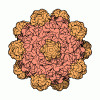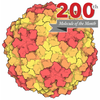+ データを開く
データを開く
- 基本情報
基本情報
| 登録情報 | データベース: PDB / ID: 9k3m | ||||||||||||||||||||||||
|---|---|---|---|---|---|---|---|---|---|---|---|---|---|---|---|---|---|---|---|---|---|---|---|---|---|
| タイトル | The structure of Microviridae PJNS001 | ||||||||||||||||||||||||
 要素 要素 |
| ||||||||||||||||||||||||
 キーワード キーワード | VIRUS / structual proteins | ||||||||||||||||||||||||
| 機能・相同性 |  機能・相同性情報 機能・相同性情報symbiont-mediated perturbation of host process / T=1 icosahedral viral capsid / viral capsid / host cell cytoplasm / symbiont entry into host cell / virion attachment to host cell / structural molecule activity / DNA binding 類似検索 - 分子機能 | ||||||||||||||||||||||||
| 生物種 |  Microviridae (ウイルス) Microviridae (ウイルス) | ||||||||||||||||||||||||
| 手法 | 電子顕微鏡法 / 単粒子再構成法 / クライオ電子顕微鏡法 / 解像度: 2.68 Å | ||||||||||||||||||||||||
 データ登録者 データ登録者 | Hu, W.L. / Chen, Y.B. / Wei, Y.M. / Gao, Y. | ||||||||||||||||||||||||
| 資金援助 | 1件
| ||||||||||||||||||||||||
 引用 引用 |  ジャーナル: Commun Biol / 年: 2025 ジャーナル: Commun Biol / 年: 2025タイトル: Structural basis for Salmonella infection by two Microviridae phages. 著者: Wanlong Hu / Zhengjie Liu / Yuming Wei / Qucheng Bian / Weiqi Lan / Chongzheng Fan / Jiaoyang Song / Qianqian Sun / Xiaojie Zhang / Yuqing Liu / Yan Gao / Yibao Chen /  要旨: The global resurgence of multidrug-resistant Salmonella species, responsible for millions of annual infections, underscores the urgent need for alternative antimicrobial strategies, such as phage ...The global resurgence of multidrug-resistant Salmonella species, responsible for millions of annual infections, underscores the urgent need for alternative antimicrobial strategies, such as phage therapy. Microviridae phages offer a promising model for studying phage-host interactions with their unique structural and infection mechanisms. Here, we identify two Microviridae phages, PJNS001 and PJNS002, with different host receptor dependencies, and determine their cryo-EM structures at 2.68 Å and 2.59 Å resolution, respectively. These icosahedral capsids with T = 1 symmetry exhibit a unique vertex reinforcement mechanism, stabilizing the viral assembly. The specific pentameric adaptations, coupled with DNA binding protein engagements and thermodynamic constraints, collectively preclude the formation of hybrid virions. Structural analysis and in situ visualization reveal spike protein features and host-attachment intermediates, informing host specificity. Together, these findings advance our understanding of Microviridae infection mechanisms and provide a structural framework for rational phage design against antibiotic-resistant pathogens. | ||||||||||||||||||||||||
| 履歴 |
|
- 構造の表示
構造の表示
| 構造ビューア | 分子:  Molmil Molmil Jmol/JSmol Jmol/JSmol |
|---|
- ダウンロードとリンク
ダウンロードとリンク
- ダウンロード
ダウンロード
| PDBx/mmCIF形式 |  9k3m.cif.gz 9k3m.cif.gz | 6.8 MB | 表示 |  PDBx/mmCIF形式 PDBx/mmCIF形式 |
|---|---|---|---|---|
| PDB形式 |  pdb9k3m.ent.gz pdb9k3m.ent.gz | 表示 |  PDB形式 PDB形式 | |
| PDBx/mmJSON形式 |  9k3m.json.gz 9k3m.json.gz | ツリー表示 |  PDBx/mmJSON形式 PDBx/mmJSON形式 | |
| その他 |  その他のダウンロード その他のダウンロード |
-検証レポート
| 文書・要旨 |  9k3m_validation.pdf.gz 9k3m_validation.pdf.gz | 2.1 MB | 表示 |  wwPDB検証レポート wwPDB検証レポート |
|---|---|---|---|---|
| 文書・詳細版 |  9k3m_full_validation.pdf.gz 9k3m_full_validation.pdf.gz | 2.4 MB | 表示 | |
| XML形式データ |  9k3m_validation.xml.gz 9k3m_validation.xml.gz | 864.3 KB | 表示 | |
| CIF形式データ |  9k3m_validation.cif.gz 9k3m_validation.cif.gz | 1.3 MB | 表示 | |
| アーカイブディレクトリ |  https://data.pdbj.org/pub/pdb/validation_reports/k3/9k3m https://data.pdbj.org/pub/pdb/validation_reports/k3/9k3m ftp://data.pdbj.org/pub/pdb/validation_reports/k3/9k3m ftp://data.pdbj.org/pub/pdb/validation_reports/k3/9k3m | HTTPS FTP |
-関連構造データ
| 関連構造データ |  62019MC  9k3nC M: このデータのモデリングに利用したマップデータ C: 同じ文献を引用 ( |
|---|---|
| 類似構造データ | 類似検索 - 機能・相同性  F&H 検索 F&H 検索 |
- リンク
リンク
- 集合体
集合体
| 登録構造単位 | 
|
|---|---|
| 1 |
|
- 要素
要素
| #1: タンパク質 | 分子量: 48500.480 Da / 分子数: 60 / 由来タイプ: 天然 / 由来: (天然)  Microviridae (ウイルス) / 株: PJNS001 / 参照: UniProt: Q2LLZ1 Microviridae (ウイルス) / 株: PJNS001 / 参照: UniProt: Q2LLZ1#2: タンパク質 | 分子量: 19112.695 Da / 分子数: 60 / 由来タイプ: 天然 / 由来: (天然)  Microviridae (ウイルス) / 株: PJNS001 / 参照: UniProt: A0A5J6T840 Microviridae (ウイルス) / 株: PJNS001 / 参照: UniProt: A0A5J6T840#3: タンパク質・ペプチド | 分子量: 4239.017 Da / 分子数: 60 / 由来タイプ: 天然 / 由来: (天然)  Microviridae (ウイルス) / 株: PJNS001 / 参照: UniProt: P69592 Microviridae (ウイルス) / 株: PJNS001 / 参照: UniProt: P69592Has protein modification | N | |
|---|
-実験情報
-実験
| 実験 | 手法: 電子顕微鏡法 |
|---|---|
| EM実験 | 試料の集合状態: PARTICLE / 3次元再構成法: 単粒子再構成法 |
- 試料調製
試料調製
| 構成要素 | 名称: Microviridae / タイプ: VIRUS / 詳細: T=1 icosahedral virus / Entity ID: all / 由来: NATURAL | |||||||||||||||||||||||||
|---|---|---|---|---|---|---|---|---|---|---|---|---|---|---|---|---|---|---|---|---|---|---|---|---|---|---|
| 分子量 | 値: 4.31 MDa / 実験値: NO | |||||||||||||||||||||||||
| 由来(天然) | 生物種:  Microviridae (ウイルス) / 株: PJNS001 Microviridae (ウイルス) / 株: PJNS001 | |||||||||||||||||||||||||
| ウイルスについての詳細 | 中空か: YES / エンベロープを持つか: NO / 単離: SPECIES / タイプ: VIRION | |||||||||||||||||||||||||
| 天然宿主 | 生物種: Salmonella | |||||||||||||||||||||||||
| ウイルス殻 | 直径: 290 nm / 三角数 (T数): 1 | |||||||||||||||||||||||||
| 緩衝液 | pH: 7.5 / 詳細: pH 7.2~7.6 | |||||||||||||||||||||||||
| 緩衝液成分 |
| |||||||||||||||||||||||||
| 試料 | 包埋: NO / シャドウイング: NO / 染色: NO / 凍結: YES | |||||||||||||||||||||||||
| 試料支持 | グリッドの材料: COPPER / グリッドのサイズ: 300 divisions/in. / グリッドのタイプ: Quantifoil R1.2/1.3 | |||||||||||||||||||||||||
| 急速凍結 | 装置: FEI VITROBOT MARK IV / 凍結剤: ETHANE / 湿度: 100 % / 凍結前の試料温度: 277 K |
- 電子顕微鏡撮影
電子顕微鏡撮影
| 実験機器 |  モデル: Titan Krios / 画像提供: FEI Company |
|---|---|
| 顕微鏡 | モデル: FEI TITAN KRIOS |
| 電子銃 | 電子線源:  FIELD EMISSION GUN / 加速電圧: 300 kV / 照射モード: FLOOD BEAM FIELD EMISSION GUN / 加速電圧: 300 kV / 照射モード: FLOOD BEAM |
| 電子レンズ | モード: BRIGHT FIELD / 倍率(公称値): 22500 X / 最大 デフォーカス(公称値): 2000 nm / 最小 デフォーカス(公称値): 800 nm / Calibrated defocus min: 400 nm / 最大 デフォーカス(補正後): 3000 nm / Cs: 2.7 mm / C2レンズ絞り径: 70 µm / アライメント法: COMA FREE |
| 試料ホルダ | 凍結剤: NITROGEN 試料ホルダーモデル: FEI TITAN KRIOS AUTOGRID HOLDER |
| 撮影 | 平均露光時間: 1.25 sec. / 電子線照射量: 50 e/Å2 / フィルム・検出器のモデル: GATAN K3 (6k x 4k) / 実像数: 4808 |
| 画像スキャン | 横: 5760 / 縦: 4092 |
- 解析
解析
| EMソフトウェア |
| ||||||||||||||||||||||||||||||||||||||||
|---|---|---|---|---|---|---|---|---|---|---|---|---|---|---|---|---|---|---|---|---|---|---|---|---|---|---|---|---|---|---|---|---|---|---|---|---|---|---|---|---|---|
| CTF補正 | タイプ: PHASE FLIPPING AND AMPLITUDE CORRECTION | ||||||||||||||||||||||||||||||||||||||||
| 粒子像の選択 | 選択した粒子像数: 711275 | ||||||||||||||||||||||||||||||||||||||||
| 対称性 | 点対称性: I (正20面体型対称) | ||||||||||||||||||||||||||||||||||||||||
| 3次元再構成 | 解像度: 2.68 Å / 解像度の算出法: FSC 0.143 CUT-OFF / 粒子像の数: 16905 / アルゴリズム: FOURIER SPACE / クラス平均像の数: 1 / 対称性のタイプ: POINT | ||||||||||||||||||||||||||||||||||||||||
| 原子モデル構築 | B value: 15.89 / プロトコル: RIGID BODY FIT / 空間: REAL | ||||||||||||||||||||||||||||||||||||||||
| 原子モデル構築 | Source name: AlphaFold / タイプ: in silico model |
 ムービー
ムービー コントローラー
コントローラー







 PDBj
PDBj


